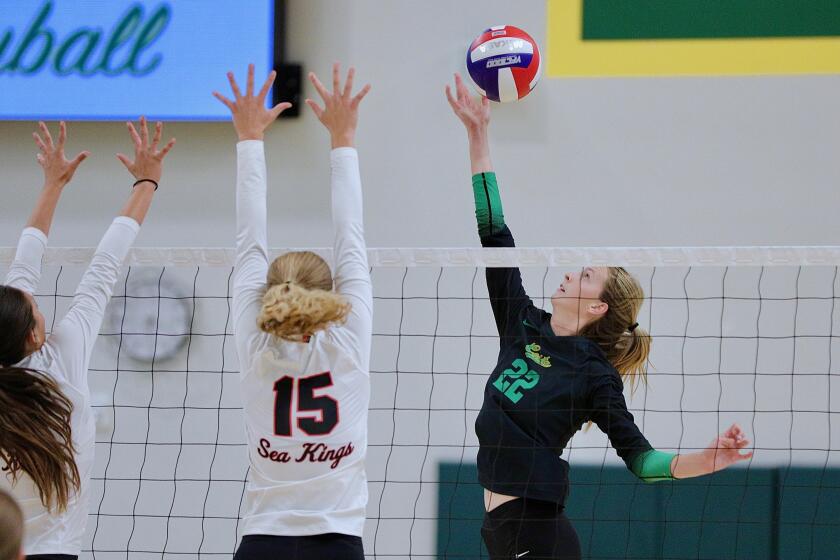Going for All of It : CSUN’s New Football Coach Keele Is Going More to the Gun Than to the Run in 1985
“If you’re a football coach, and you’re 2-8, what have you got to lose? I thought a change would be good for us.”
-- CSUN’s Tom Keele
Tom Keele compares himself to Seattle Seahawks Coach Chuck Knox, whose football philosophy could be described as pre-Red Grange.
And the Cal State Northridge football coach is as likely to order the bomb on first down as Dan Fouts is to hand off. To Keele, there is a time and place for trick plays--after practice, while horsing around with a 50-point lead in a game of flag football.
It makes people wonder what prompted him to abandon his mundane I and pro-set offense this spring for the unorthodox run-and-shoot attack popularized by Denver Gold Coach Darrel (Mouse) Davis of the United States Football League.
A 3-7 season, such as the one the Matadors experienced in 1984, has a way of promoting change.
“If you’re a football coach, and you’re 2-8 (Northridge won a game by forfeit), what have you got to lose? You might as well go for it,” Keele said. “I thought a change would be good for us.”
But so radical a change? Very few coaches know exactly what the run- and-shoot offense is, much less how to implement it.
Keele, however, received a six-week clinic on the run and shoot from Davis, perhaps the offense’s leading exponent, when the Gold trained at CSUN from Jan. 19 to March 2. The Matadors’ coach attended practices, meetings and film sessions and took 154 pages of notes.
After long deliberation, Keele made the switch. The first thing he did was get a copy of the book, “Run and Shoot Football: The Now Attack,” written in 1965 by Glenn (Tiger) Ellison, who is considered the founder of the offense.
Then he told his assistant coaches of his plans. “They didn’t know anything about (the run and shoot),” Keele, 51, said.
That puts them in the majority. What exactly is this offense that sounds like a scene from a James Bond movie?
“A single back, four wide-outs with motion, with an emphasis on the pass--that’s our run and shoot,” said Davis, 52, who first gained notoriety with the offense while coaching June Jones III and Neil Lomax at Portland St. in the ‘70s and early ‘80s.
Northridge’s run and shoot is patterned after the Gold’s version, right down to play terminology. Obviously, it’s a pass-oriented attack featuring two wide receivers, two “wings” or flankers and a lone running back.
Its most unique aspect is that four receivers often can choose their patterns depending on how the defense plays them. Keele calls these “option routes,” and it’s the quarterback’s responsibility to read the receiver and get him the ball.
“The pattern is dictated by how the defense reacts,” Keele said. “The receiver is going to run to an area away from the defensive back.”
Generally, the primary receiver is the only player running an option route. The other three receivers have defined patterns, so the quarterback knows where to find them should the primary target be covered.
The two wide receivers in Keele’s offense are labeled Z and X, the wings Y and W. A typical pass play is Load 60 Z Choice.
On this play, “load” indicates that the right wing, Y, will go in motion to the left, and 60 refers to the quarterback rolling to the right. The primary receiver is Z, the split end on the right side, and he has a “choice” of three patterns--streak, post or sideline--depending on the defense.
If Z is covered, the quarterback looks to his three secondary receivers, who have run predetermined routes.
“You’ve got one play, but six different coverages,” Keele said.
According to Davis, there are three key elements if the run-and-shoot offense is to keep from firing blanks. The first is a mobile quarterback, “one with a good arm that’s got some poise. That is imperative if you’re going to have success,” Davis said.
“Second, you need enough young fellows to get down the field to catch the ball. And third, a strong single back, someone who can run the football if they start covering the pass,” Davis said.
The Matadors would appear to have all three areas covered.
Five talented quarterbacks came out for spring practice, including Chabot Community College transfer Danny Fernandez, who completed 11 of 13 passes for two touchdowns in the offense’s debut last week against the Northridge alumni.
A sixth quarterback, Tim Rapp, who started the Matadors’ final three games last year, is presently playing baseball for CSUN and couldn’t attend spring practice. He’ll have a lot of catching up to do when he comes out for the team in the fall.
The Matador receiving corps includes speedster Tralaski Trass, who last season led the team in receiving yardage (264) and average yards per catch (18.9).
The starting wings are expected to be Richard Brown, the team’s second-leading rusher and third-leading receiver in ‘84, and Eric Davis, who redshirted last year because of a knee injury, but in ’82 led Northridge in rushing and was second in receiving.
The key to the Matadors’ season may be the success of their single back, Mike Kane. The 5-10, 180-pound tailback, who will be a junior this fall, led the Western Football Conference in rushing the past two years and needs just 239 yards to become CSUN’s all-time leading rusher.
Because Keele expects to see a lot of nickel defenses (five defensive backs instead of the normal four) against the run and shoot, he feels the team’s chances hinge on the ground game, which has been the Matadors’ strength the last two years.
“If we see a lot of nickel defenses and pass coverage, we’ll have to be able to run,” Keele said. “Our asset is our backs--Davis, Kane and Brown. We’ll run inside counters with them.”
The Northridge coach views the run-and-shoot offense as an equalizer for his club in the WFC.
“All of the schools we play have more scholarships than we do, but with this offense, maybe we can play on an equal basis,” Keele said. “No matter how we do, it’s a good offense. People have had success with it.”
Especially Davis. At Portland St. in 1980, Davis’ team scored 105 points against Delaware St., 93 vs. Cal Poly Pomona and 75 against Weber St.
Northridge played Portland St. that same year. “I was scared to death,” Keele said. “We had film and we practiced against (the run-and-shoot offense), but we didn’t know it.”
Fortunately for the Matadors, Lomax & Co. took it easy on them, winning 34-21.
Davis led the Toronto Argonauts to the Canadian Football League Grey Cup playoffs with the run and shoot three years ago, and last year he was an assistant coach for the USFL’s Houston Gamblers, where Jim Kelly set a single-season passing record with the offense.
Even with the impressive numbers Davis has posted with the run-and-shoot attack, no major colleges or National Football League teams have yet adopted it. But the Matadors, who conclude spring practice today with the Red and White scrimmage at 10 a.m., seem to like the new offense and, according to Keele, are adjusting well to it.
“It’s a lot of fun,” Fernandez said. “It seems like there’s always something new happening on each play. We could run the same play four or five times and you wouldn’t even know it’s the same play.”
Keele knows he doesn’t want to go through another season like 1984. “I don’t ever anticipate being that bad again,” Keele said.
Or that conservative, now that he’s committed to the run-and-shoot offense.
ch RUN AND SHOOT OFFENSE
Get our high school sports newsletter
Prep Rally is devoted to the SoCal high school sports experience, bringing you scores, stories and a behind-the-scenes look at what makes prep sports so popular.
You may occasionally receive promotional content from the Los Angeles Times.



